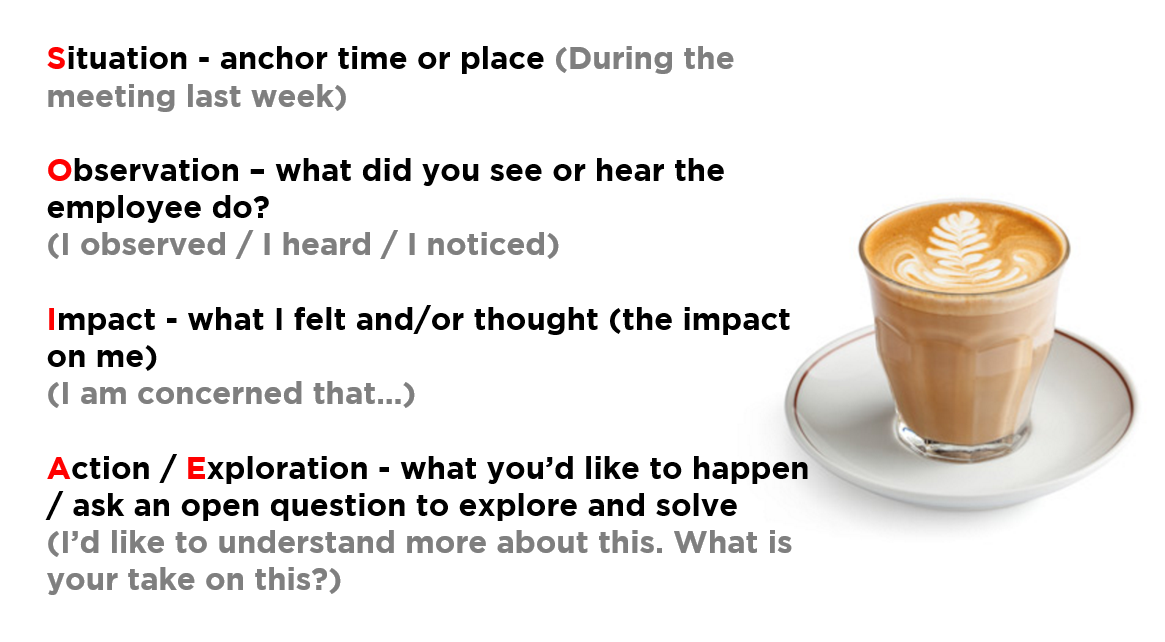Simple ‘TIPs’ for providing feedback – using SOI
When providing feedback to people – reinforcing feedback about what is working, developmental feedback about opportunities to improve or corrective feedback about what is not working, it helps to have a simple ‘hand rail’ to guide you. This post gives you a few ideas that have been proven to help with leaders providing more effective feedback to others.
Start by sharing the intent behind the feedback
It is important that you have clear intentions before you open your mouth – Is this feedback to motivate or feedback to change? If it is to make the person feel lousy – then this is not the right time to have this conversation! Wait until your intentions are more positive.
 Before you engage in the detail, it helps to start by sharing this intent first, then follow it up with the ‘content’. Share the WHY first and then the WHAT second (for example the feedback might be to help enhance development and growth, improve effectiveness, strengthen confidence or relationships, or drive better performance). If a person knows why you are providing the feedback they don’t spend their time trying to guess your drivers are they are much more open to listening.
Before you engage in the detail, it helps to start by sharing this intent first, then follow it up with the ‘content’. Share the WHY first and then the WHAT second (for example the feedback might be to help enhance development and growth, improve effectiveness, strengthen confidence or relationships, or drive better performance). If a person knows why you are providing the feedback they don’t spend their time trying to guess your drivers are they are much more open to listening.
(Click here to see a post on 19 words that been proven to have a ‘dramatic effect in boosting performance and effort.’)
Use a simple framework to deliver your feedback and engage in a conversation. This is the ‘WHAT’ piece of the feedback conversation.
This posts shares two techniques that can help you to provide more effective feedback and engage in a productive conversation.
One technique is the ‘TIPS’ technique

It helps if you
- are specific about the situation (when) and behaviour (what was done / said) that has been observed,
- explore the impact that this has had (on you and / or others), then
- agree a plan moving forward
- see if there is anything you can do to help sustain or support this plan
Depending on the situation at hand, and your objectives in discussing it, you will need to decide how much ‘telling’ is involved on your part, and where ‘asking’ in the ‘I’ and ‘P’ stages is more effective.
Keep in mind, that questions can help the other person gain more insight, so asking them about the impact they may have had may help to take them out of their ‘blind spot’ and increase their awareness of the impact they may have had. When it comes to agreeing a way forward, questions can also be helpful, in encouraging greater ownership and accountability for the things the person is going to keep doing / start doing / stop doing or do more or less of.
The other technique is the SOI model (sometimes called SBI model for feedback)
The SOI model is very similar to the TIPS model, but offers a little more distinction on sharing an observation of the behaviour and then the impact.
Once the impact has been shared, you share your goal for the remainder of the conversation and engage in exploration by asking an open ended question. This enables the discussion to then move more towards a coaching conversation – providing feedback using a coaching approach, if you will.
During this exploration, the rest of TIPS can be embedded into the conversation, ie agreeing a Plan / a way forward and seeing what Support might be needed.
A video example
We recently came across a simple video with Nick Petrie from the Center for Creative Leadership. He calls his model the SBI model – which is basically the T and I part of tips and similar to the SOI approach.
If you want to view this youtube video follow this link.
Want a template?
Click here to download a template to help you prepare.
Remember, you cannot control the response you might get from the person on the receiving end of constructive feedback, and ultimately you can’t make others ‘feel safe’ – they own their thinking and emotions, but you can make it easier for them to ‘feel safe’ by following these steps.
Want another video?
Click here to see an excellent 5 minute TED video on giving effective feedback that incorporates the ideas expressed here – and has a simple visual to print.
